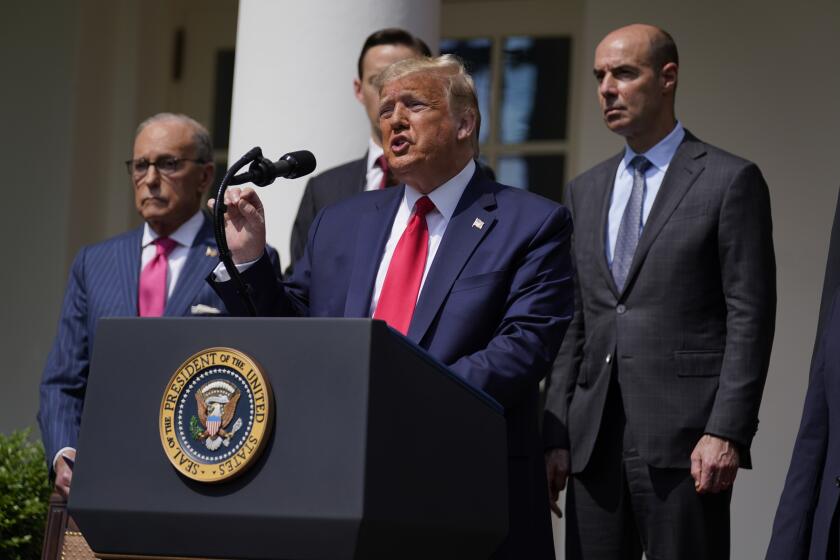NEWS ANALYSIS : Economists, Public Part Ways Over End of Recession
Many economists maintain that the financial landscape is improving, but consumers just don’t believe it.
A recent nationwide survey conducted by the Los Angeles Times showed that more than eight out of 10 Americans believe that the United States is still in a recession. And one out of three describes the downturn as serious.
That’s despite assurances from economists, policy-makers and government leaders that the recession is over and that the good times are just around the corner.
Why do consumers so strongly disagree with the experts? There is a wide array of theories, including the fact that there is often a lag between the time the economy starts to rebound and the time consumers notice.
But another theory that seems to make sense is this: Some statistics that impress the experts don’t concern the efforts of putting food on the average American’s table.
“The statistical abstraction of the economy has very little to do with real life,” says Michael Aronstein, president of Comstock Partners in New York. “Parts of the economy are recovering. But they are probably not the parts that have the most profound financial implications to people like you and I.”
For example, the government’s leading indicators of economic health include items such as stock prices, how fast vendors fill their orders, building permits and the money supply. And all these items, as well as consumer spending and confidence, have risen somewhat in the past few months.
But for many people, economic well-being is defined as simply having a job and having enough money to spend. And the statistics on this score are far less positive.
In June, the unemployment rate rose to its highest level in five years. Now, seven out of every 100 Americans are out of work. That’s up from about five out of every 100 two years ago. It is also a somewhat euphemistic way of saying that about 8.7 million individuals can’t find jobs right now.
Statistics that show how much money Americans have to spend is equally depressing: Personal income has grown about 3% so far this year, but inflation is up 5%.
Translation: Average Americans actually have less spending money today than they did at the beginning of the year. In dollars and cents, in fact, that little 2% drop means that a $20,000 annual income buys $400 less in goods and services than it did before.
Worse still, federal taxes have risen and many states have hiked property, income and sales taxes as well. Again, that leaves consumers with less money to put in their pockets and bank accounts.
Nevertheless, the bulk of the nation’s best-known economists believe that things are getting better.
However, many of these experts believe that it will take at least six months before the benefits of an improving economy start to filter down to the average American. They also note that the recovery will not be felt evenly in all parts of the country.
Employment statistics underscore the point. A far larger percentage of the population in Massachusetts and New York are out of work than in Texas or North Carolina, according to government statistics. Meanwhile, the job picture seems to be improving in Michigan and Pennsylvania, but it is deteriorating in California and Illinois.
Moreover, economic gains are expected to remain modest--possibly so modest that consumers will have difficulty seeing those gains. Eventually the inching ahead will result in some giant steps, though, these economists believe.
“The economy is improving, but it is a very little and very spotty recovery,” said Joseph Wahed, senior vice president and chief economist at Wells Fargo Bank. “The nation is in a period of very unsatisfactory calm.”
There are also a few experts who believe that the recovery could be fleeting. The nation could dip back into a second, and possibly deeper, recession only months after pulling itself out of the first downturn.
If that’s the case, the upturn may come and go before most of us even notice.
Monthly Unemployment Percent of work force, seasonally adjusted June, ‘91: 7.0% May, ‘91: 6.9% June, ‘90: 5.3% Source: U.S. Dept. of Labor
Unemployment
June,1991 1990 1989 1988 1987 Civilian labor force (year-end, unless otherwise indicated)* 125.6 124.8 123.9 121.7 119.9 Unemployed workers* 8.7 6.9 6.5 6.7 7.4 Unemployment rate 7.0% 5.5% 4.9% 5.5% 6.2%
* in millions
Source: Department of Labor, Bureau of Labor Statistics.
More to Read
Inside the business of entertainment
The Wide Shot brings you news, analysis and insights on everything from streaming wars to production — and what it all means for the future.
You may occasionally receive promotional content from the Los Angeles Times.










